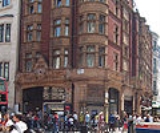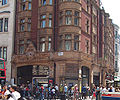
Harry Bell Measures
Encyclopedia

He had a varied career. From 1884 - 1892 he was in-house architect for William Willett
William Willett
William Willett , was an English builder and a tireless promoter of British Summer Time.-Biography:Willett was born in Farnham, Surrey, in the United Kingdom, and educated at the Philological School. After some commercial experience, he entered his father's building business, Willett Building...
producing high quality housing for the well-heeled in London and South East England; these were normally in the an ornate red brick Queen Anne style which was popular at the time.
He is also responsible for a number of English "improved" housing developments for working men, such as the Rowton Houses
Rowton Houses
Rowton Houses were a chain of hostels built in London, England by the Victorian philanthropist Lord Rowton to provide decent accommodation for working men in place of the squalid lodging houses of the time....
in London
London
London is the capital city of :England and the :United Kingdom, the largest metropolitan area in the United Kingdom, and the largest urban zone in the European Union by most measures. Located on the River Thames, London has been a major settlement for two millennia, its history going back to its...
and Birmingham
Birmingham
Birmingham is a city and metropolitan borough in the West Midlands of England. It is the most populous British city outside the capital London, with a population of 1,036,900 , and lies at the heart of the West Midlands conurbation, the second most populous urban area in the United Kingdom with a...
. He also designed the original station buildings for the Central London Railway
Central London Railway
The Central London Railway , also known as the Twopenny Tube, was a deep-level, underground "tube" railway that opened in London in 1900...
, now the Central line
Central Line
The Central line is a London Underground line, coloured red on the tube map. It is a deep-level "tube" line, running east-west across London, and, at , has the greatest total length of track of any line on the Underground. Of the 49 stations served, 20 are below ground...
of London Underground
London Underground
The London Underground is a rapid transit system serving a large part of Greater London and some parts of Buckinghamshire, Hertfordshire and Essex in England...
, that opened on 30 July 1900.
Measures was later the Director of Barrack Construction for the British War Office
War Office
The War Office was a department of the British Government, responsible for the administration of the British Army between the 17th century and 1964, when its functions were transferred to the Ministry of Defence...
and was responsible for buildings such as Redford Barracks
Redford Barracks
Redford Cavalry and Infantry Barracks are located on Colinton Road, near the Edinburgh City Bypass, east of the suburb of Colinton in Edinburgh, Scotland....
in Edinburgh
Edinburgh
Edinburgh is the capital city of Scotland, the second largest city in Scotland, and the eighth most populous in the United Kingdom. The City of Edinburgh Council governs one of Scotland's 32 local government council areas. The council area includes urban Edinburgh and a rural area...
.
Other works
- Works for Artisans, Labourers & General Dwellings Company on Leigham Court Estate, StreathamStreathamStreatham is a district in Surrey, England, located in the London Borough of Lambeth. It is situated south of Charing Cross. The area is identified in the London Plan as one of 35 major centres in Greater London.-History:...
.
Central London Railway stations
Measures designed the following stations on the original section of the Central London Railway:- Shepherd's Bush - building demolished and rebuilt in 2008.
- Holland ParkHolland Park tube stationHolland Park is a London Underground station. On the Central Line, it lies between Shepherd's Bush and Notting Hill Gate stations, in Travelcard Zone 2.-History:...
- station building remains in use - Notting Hill GateNotting Hill Gate tube stationNotting Hill Gate tube station is a London Underground station in the street known as Notting Hill Gate. On the Central Line, it is between Holland Park to the west and Queensway to the east. On the District Line and Circle Line it is between High Street Kensington and Bayswater stations...
- building demolished and rebuilt - QueenswayQueensway tube stationQueensway is a London Underground station on the Central Line, just inside the boundary of the City of Westminster with the Royal Borough of Kensington and Chelsea. It is at the junction of Queensway and Bayswater Road, and is northwest of Kensington Gardens...
- opened as Queens Road. Building remains in use - Lancaster GateLancaster Gate tube stationLancaster Gate is a London Underground station located on the Central Line near Lancaster Gate on Bayswater Road in Bayswater , to the north of Kensington Gardens. It is between Queensway and Marble Arch on the Central line and is in Travelcard Zone 1.-History:Lancaster Gate station was opened on...
- building demolished and rebuilt - Marble ArchMarble Arch tube stationMarble Arch is a London Underground station in the City of Westminster. The station is between Lancaster Gate and Bond Street stations on the Central line, and is in Travelcard Zone 1.-History:...
- Oxford Street entrance remains - Bond StreetBond Street tube stationBond Street tube station is a London Underground station on Oxford Street, near the junction with New Bond Street. Note that the street-level entrances are approximately 200 metres west of New Bond Street itself...
- Oxford Street entrance remains - Oxford CircusOxford Circus tube station-External links:* ** ** * Plans of the station after the Victoria Line works , , *...
- well preserved example of the type - Tottenham Court RoadTottenham Court Road tube stationTottenham Court Road is a London Underground station in central London. It is an interchange between the Central line and the branch of the Northern line.On the Central line it is between and , and on the Northern line it is between and...
- opened as Oxford Street. Demolished in 2009. - British MuseumBritish Museum tube stationBritish Museum tube station was a station on the London Underground's Central Line, located on Bury Place, close to the British Museum in central London, England.-History:...
- station closed in 1933 when new Central line platforms opened at HolbornHolborn tube stationHolborn is a station of the London Underground in Holborn in London, located at the junction of High Holborn and Kingsway. Situated on the Piccadilly Line and on the Central Line , it is the only station common to the two lines, although the two lines cross each other three times elsewhere...
. Demolished in 1990s. - Chancery LaneChancery Lane tube stationChancery Lane is a London Underground station in central London. It is on the Central Line between St. Paul's and Holborn stations. The station is located at the junction of High Holborn, Hatton Garden and Gray's Inn Road with subway entrances giving access to the ticket office under the roadway...
- High Holborn station building remains but no longer used for access to station - St Paul'sSt. Paul's tube stationSt. Paul's tube station is a London Underground station in the City of London on the Central Line, between Bank and Chancery Lane stations, and is in Travelcard Zone 1....
- opened as Post Office. Demolished in 1930s. - Bank - no surface building constructed
Measures also designed the original station building for railway's Wood Lane station
Wood Lane (Central Line) tube station
Wood Lane tube station is a disused station on the Central Line of the London Underground. It was built to serve the Franco-British Exhibition of 1908 and the 1908 Summer Olympics....
, which opened in 1908 for the Franco-British Exhibition
Franco-British Exhibition (1908)
The Franco-British Exhibition was a large public fair held in London in the early years of the 20th Century. The exhibition attracted 8 million visitors and celebrated the Entente Cordiale signed in 1904 by the United Kingdom and France....
, although this was later modified to a design by Stanley Heaps
Stanley Heaps
Stanley A. Heaps was an English architect responsible for the design of a number of stations on the London Underground system as well as the design of train depots and bus and trolleybus garages for London Transport.-Works:...
. The station was closed in 1947 and the building has been demolished.

